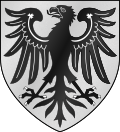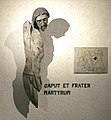Echternach
| coat of arms | map |
|---|---|

|

|
| Basic data | |
 Echternach |
|
| State : |
|
| Coordinates : | 49 ° 49 ' N , 6 ° 25' E |
| Canton : | Echternach |
| Residents : | 5618 (January 1, 2019) |
| Area : | 20.5 km² |
| Population density : | 274.2 inhabitants / km² |
| Municipality number: | 1005 |
| Website: | www.echternach.lu |
| politics | |
| Mayor: | Yves Wengler ( CSV ) |
| Elective system : | Proportional vote |
Echternach ( Luxembourgish Iechternach, Eechternoach ) is a city and a municipality in the Grand Duchy of Luxembourg and the capital of the canton of the same name .
Echternach lies on the Sauer , which also forms the border with Germany here. Neighboring communities are Berdorf in the north , Consdorf in the west , Bech and Rosport in the south and the German community Echternacherbrück in the northeast .
Echternach is the capital of the touristically attractive Little Luxembourg Switzerland (French: Petite Suisse luxembourgeoise). In the south of Echternach is the Echternach lake . Among the secular buildings in the city, the Gothic Dingstuhl (1444), popularly known as the " Dënzelt ", deserves special mention. The word corresponds to the Old High German " Thing " (advice) and means the seat of the former lay jury; it is now the city's boardroom (at the market).
coat of arms
The coat of arms of the city of Echternach is identical to the coat of arms of the Imperial Abbey of Echternach and shows, like almost all imperial territories in the Holy Roman Empire of the German Nation, the imperial eagle of the Holy Roman Empire of the German Nation .
history
In Roman times there was a large, representative villa rustica in Echternach , probably the center of a large country estate. The extent to which this large Roman complex is the basis of the early medieval development is increasingly discussed in research. Founded by St. Willibrord in 698 on a gift from Irmina von Oeren , Echternach is the oldest city in Luxembourg with its abbey and basilica. The former imperial abbey of Echternach is famous for the illumination that flourished in the Middle Ages . The best-known works include the Golden Gospels of Echternach (Latin Codex Aureus Epternacensis, 11th century; today Germanisches Nationalmuseum Nürnberg ) and the Golden Gospel Book of Heinrich III. (Latin Codex Aureus Spirensis or Codex Aureus Escorialiensis, Speyer Gospels; today El Escorial , Madrid ).
In 1236 Echternach received city rights. The fortification, which is said to go back to the 10th century in a primitive form and was expanded in the 13th century, was provided with 20 shell towers, 4 city gates and a 2000 m long wall. Much of the complex was not destroyed until the 19th century. The remaining towers were auctioned off in 1813 and converted for residential purposes.
In the line of sight to the basilica, one of the city's oldest landmarks rises, the striking building of a former court house (“ Dingstuhl ” or “ Dënzelt ”). It was built in 1236, bought up by the abbot at the time in 1374 and destroyed by fire in 1444. The building then underwent a number of renovations: in 1520 in the Renaissance style, in the 18th century in the Baroque style, and in 1895 in the Neo-Gothic style. The statues on the facade are the work of the Aachen sculptor Lambert Piedboeuf from 1896. They depict the cardinal virtues, the Virgin Mary, King Solomon and Abbot Robert von Monreal († 1539).
The prelate garden (also known as the orangery) was laid out after 1731 by Abbot Gregorius Schouppe based on French models on the site of the former city wall. The orangery, built for the wintering of exotic plants, was completed in 1736, probably according to the plans of Leopold Durand. The statues on the facade represent the four seasons. The sculptures are said to come from the circle of the Würzburg sculptor Ferdinand Tietz . The abbey and orangery now serve as a grammar school.
In October 1886 Echternach was the first city in Luxembourg and one of the first cities in Europe to have public and private electrical lighting. The initiator and operator of the system was the inventor Henri Tudor , whose lead-acid batteries supplied the electricity ( direct current ). In addition, the first film projection in Luxembourg took place in Echternach in 1896. Opposite the former Hôtel du Cerf there is still a volunteer-run cinema.
Culture and sights
St. Willibrord's Basilica
Abbey and downtown
city wall
Drawing in the Cartularium by Johannes Bertels (Archives Nationales de Luxembourg)
Echternach jumping procession
On the Tuesday after Pentecost , the Echternach jumping procession takes place, an annually celebrated dance procession, which is carried out in a similar form in the Trier district of Biewer with the so-called archipelago jump . During the jumping procession, the participants "jump" to marching music from the inner courtyard of the former abbey through the city to the Echternach basilica, the burial place of St. Willibrord . The procession honors the saint who set out from here to do his missionary work in Friesland. Numerous believers from the missionary areas also regularly take part in the event.
How it came to jumping is not clear. One theory says that the jumps go back to the movements of epileptics who hoped that a pilgrimage would cure their illness. However, recent research prefers the thesis that the jumping procession is much older than the worship of Willibrord and that it emerged from Germanic and early Christian cult dances. The Echternach jumping procession has been part of the intangible world cultural heritage of UNESCO since 2010 .
Music festivals
Festival International Echternach
The two Luxembourg music lovers Georges Calteux and Jean Kraft came up with the idea of using the Echternach basilica for concerts at a concert in an abbey church in Spain. Back home, the idea fell on fertile ground in 1975 and quickly found many friends and sponsors. Among them is the world-famous pianist Cyprien Katsaris , who shaped the festival as musical director for more than 30 years.
Adrien Meisch, former ambassador of Luxembourg and musician, played a key role in the history of the Festival International Echternach as its president from 1985 to 2007. On November 20, 2007, Georges Santer, currently the Luxembourg ambassador in Paris , took over the presidency. Adrien Meisch remains connected to the festival as honorary president.
Musical greats such as Benny Goodman , Yehudi Menuhin , Mstislaw Rostropowitsch , Montserrat Caballé , Anne-Sophie Mutter , Gidon Kremer , Alfred Brendel or, in 2009 z. B., Arcadi Volodos , Christian Zacharias or George Benson (to name just a few) have performed in Echternach as well as young talents or award winners from home and abroad. Numerous works were premiered in Echternach. They were created on behalf of the Festival International Echternach and support young composers.
Musically, the festival spans a range from medieval sounds to classical music and from jazz to world music . Since 2008 there has also been a jazz festival in September as part of the Echternach Festival.
The following venues are available:
- the Basilica
- the church of St. Pierre et Paul
- the Trifolion cultural center (since 2008)
- the Philharmonie Luxembourg
and occasionally other venues
E-Lake Festival
The e-Lake festival is a free three-day music festival that has been organized by teenagers for teenagers since 1983 in August. The music styles range from rock and pop , electro and house to reggae .
Personalities
sons and daughters of the town
- Henry IV (1112–1196), Count of Luxembourg
- Charles Munchen (1813–1882), lawyer and politician
- Jos Namur (1823–1892 ibid), pharmacist and high school professor
- Caspar Mathias Spoo (1837–1914), industrialist and politician
- Rudolf Palgen (1895–1975), Romanist, Italianist, Germanist and Dante researcher
- Robert Schaffner (1905–1979), politician (DP), including two mayors of Echternach
- Paul Spang (1922–2009), historian and archivist
- Victor Conzemius (1929–2017), church historian
- Jules Hoffmann (* 1941), biologist and Nobel Prize laureate for physiology or medicine
- Hans Günter Hockerts (* 1944), German historian
- Carole Dieschbourg (* 1977), politician
literature
- Camille Wampach: Documents and source book on the history of the old Luxembourg territories up to the Burgundian period , 10 volumes; Luxembourg 1935–1955.
- Henri Trauffler: The abbey town of Echternach in the Middle Ages . Trier 1996 (Phil. Diss.).
- Camille Wampach : History of the Echternach rulership in the early Middle Ages, studies on the person of the founder, on the monastery and economic history based on the liber aureus Epternacensis (698–1222). Luxembourg 1929/1930.
- Thomas Webers, family book of the Echternach community 1796–1923 , Echternach community, 2016
- Michele C. Ferrari: The Echternach Abbey 698–1998 . Cludem, Luxembourg 1999, ISBN 2-919979-12-4 .
Individual evidence
- ↑ STATEC Luxembourg - Population par canton et commune 1821–2019 (French)
- ↑ Jos. A. Massard: 1886–1996: One hundred and ten years of electric light in Echternach. A contribution to the history of public and private lighting in the 19th and early 20th centuries in Luxembourg with a view of the German border area. (PDF; 12.99 MB); Annuaire de la Ville d'Echternach 1996; Pp. 101-144.
- ↑ Ciné Sura: History. Ciné Sura Echternach, accessed June 7, 2018 .
- ↑ Hopping procession of Echternach. UNESCO, accessed June 7, 2018 .


























